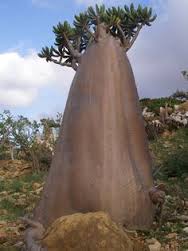Nathen Reese
Socotra Island, off the coast of Yemen in the Gulf of Aden, is home to hundreds of native plant species. The island is well known for “alien plants” such as trees that grow to resemble enormous mushrooms and a Cucumber Tree that is a distant relative of the food that grows in many gardens in the United States. The island also has a problem with invasive species. Although not many of the species come to Socotra naturally, since it is isolated and far enough away from land that not a lot of spreading can happen from the mainland, it is still an issue. 88 species of “alien plants” occur on the island and of those 88, 18 could be categorized as naturalized species and 4 could be considered invasive. (Senan et. al., 2012) These invasive species can be attributed to the beginning development of the island, which has remained largely untouched for most of history. Some of them, such as certain types of weeds, have come along with plants used as a means for food. (Senan et. al., 8)
The origins of these invasive species can largely be traced back to Africa and Asia, which is understandable given Socotra’s location. Not all of the invasive plants are adapted to their location, though. Some are placed where they are for economic reasons (food) or for ornamental purposes for the people who inhabit the island.
Sources
Senan, Ali S., Frederico Tomasetto, Alessio Farcomeni, Rayasamuda K. Somashekar, and Fabio Attorre. “Determinants of Plant Species Invasions in an Arid Island: Evidence from Socotra Island (Yemen).” Diss. 2012. Springer Science + Business, 15 July 2012. Web.

Sweet! Wonder how the ratio of natural vs. invasive compares to that of the US.
LikeLike